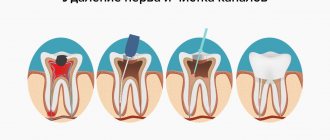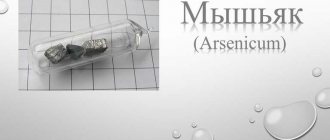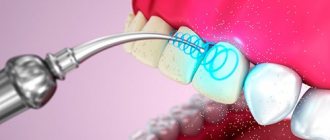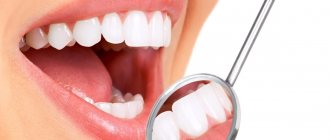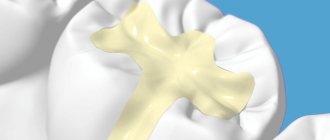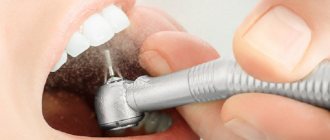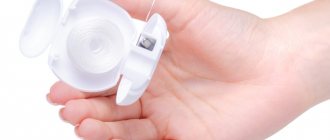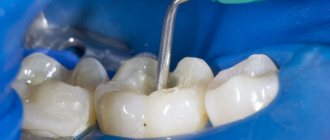What is root canal cleaning?
In order to understand how canal cleaning occurs, you need to know what it is. This part is the cavity inside the tooth, filled with tissue base and nerve endings. Inflammation may cause pain. If the problem is ignored for a long period of time, tooth extraction becomes necessary.
Inflammation of soft tissue (pulp) requires immediate cleaning of dental cavities; each person has a different number of them. This exercise is problematic because it is hidden from view and requires surgical intervention.
Modern methods of cleaning cavities guarantee the preservation of the bone structure and the return of the enamel to its natural color. In times when dentistry was underdeveloped, inflammation of the pulp led to tooth extraction.
The main problem is determining the number of cavities in the patient. It is also necessary to know their exact dimensions, otherwise cleaning may not occur completely. To avoid this, dentists first take an x-ray, after which they begin to remove the deposits.
The meaning of endodontic treatment and the canal cleaning procedure
Endodontic treatment involves the elimination of inflammatory processes in the dental pulp and periodontium - the tissues surrounding the apices of the roots. For this purpose, surgical intervention and a large number of root canal obturation techniques are used. These measures are aimed at preserving the affected unit. Due to the complexity of endodontic treatment, it should only be carried out by a highly qualified specialist with sufficient experience.
This treatment method is used if:
- the need for re-therapy after endodontic intervention;
- acute and chronic periodontitis;
- pulpitis that cannot be treated conservatively;
- tooth fracture associated with damage or death of the pulp;
- the need for dental prosthetics using stump inlays or crowns, the installation of which requires significant grinding of the enamel;
- the need to prepare the tooth for intracanal bleaching.
Endodontic treatment consists of several stages. Standard therapy includes:
- anesthesia;
- opening of the tooth cavity;
- endodontic treatment of root canals;
- obstruction;
- installation of a filling or crown.
Clean the channels using:
- Instrumental treatment of root canals. It is carried out by one of two methods: apical-coronal, in which the removal of infected tissue is carried out from the apex of the root to its mouth, and coronal-apical with the reverse sequence of actions.
- Medicinal treatment of canals. The root canals are irrigated with medicinal solutions.
During the cleaning procedure, modern methods of pain relief are used. Patients with a low pain threshold may need additional treatment of the needle insertion point with an anesthetic application. After the painkiller begins to take effect, begin root canal cleansing, which includes:
- Isolation of the working area using a rubber dam, due to which the mucous membrane is reliably protected from possible burns as a result of the use of disinfectants. In addition, this measure allows you to protect the tooth cavity from saliva and other substances getting into it.
- Drilling a hole to gain access to the affected roots. On the front teeth, the hole is made on the inner wall, on the chewing units - on the surface.
- Channel expansion. Instrumental treatment involves the use of instruments, when inserted into the canal, the remains of necrotic tissue are removed from the walls of its cavity.
- Disinfection of the cleaned cavity. Sodium hypochlorite is injected using a very thin disposable needle.
We invite you to familiarize yourself with: Filling teeth with gutta-percha pins: disadvantages and advantages
After completing the above measures, the tooth is ready for installation of a filling or crown. The method of restoring his chewing function depends on the specific situation. The video below shows how cleaning is carried out.
In order for the dentist to choose the right treatment tactics, he should obtain maximum information about the condition of the tooth. Additionally, it is necessary to find out if the patient has an allergic reaction to medications, since they are required to be used when cleaning canals.
Collection of information:
- interviewing the patient (nature of pain, sensations);
- conducting an initial examination;
- sending a patient to get an image.
If the patient is a pregnant woman, then it is more rational to choose a study performed using a visiograph. The most informative is a 3D image created by a tomograph. Based on visual data, the dentist determines the length of the canal, allowing you to accurately select the instrument. There is a more accurate way to determine the distance using an apex locator, which displays a picture on the screen that allows you to determine the distance of the inserted instrument from the apex of the root. This method prevents breakage of endodontic devices during cleaning.
X-ray of a tooth
Why is channel cleaning necessary?
If inflammatory processes begin in the soft tissues, they are guaranteed to lead to necrosis of other parts of the tooth. To avoid negative consequences, such outbreaks should be removed immediately. Both caries and pulpitis can lead to necrosis of the cavity. These diseases instantly cause pain, so cleaning of the dental canals is required.
The complexity of this operation depends on the degree of neglect of the disease. Sometimes it takes several hours for a high-quality procedure; in complex cases, you have to visit the dentist several times.
Cleaning cavities is necessary, since ignoring the problem will lead to the need to remove the tooth with its subsequent restoration in the form of a prosthesis. Such a procedure will be much more expensive and take longer to complete.
After cleaning the canals, there must be a recovery period, during which the patient may feel some discomfort in the affected area. The tooth will react sharply to temperature changes and pressure. Also, after the procedure, a repeat x-ray is required.
Indications for cleaning
This procedure is carried out if such serious reasons arise as:
- pulpitis;
- periodontitis;
- pain syndrome that can develop under the influence of internal and external factors.
Cleaning the tooth canal can also be carried out before prosthetics, since the installation of implants involves the removal of nerves.
Main contraindications
In dentistry, there are cases when cleaning dental cavities is not a practical operation. For example, if the base of the root is fractured, the procedure will not bring any results.
This operation should not be performed if an infectious disease is detected in the oral cavity. While cleaning the canals, bacteria can get inside, which will have consequences. To carry out the procedure safely, it is necessary to thoroughly disinfect the oral cavity and only then begin cleaning.
Any surgical intervention in the oral cavity is not recommended for people who have suffered a heart attack or stroke. Such diseases are a serious stress for the body, and subsequent interventions can lead to a new attack.
Canal cleaning is not possible if the patient has diabetes. With this disease, any irritating factor can lead to complications. Before the operation, it is necessary to undergo a thorough examination. A competent doctor will select the appropriate anesthesia and other medications.
Installing a seal
The dentist selects a suitable filling material, which must meet the following requirements:
- have antimicrobial, hypoallergenic properties and high biocompatibility;
- be plastic and airtight at the same time;
- Do not dye the fabric of the unit being restored.
The filling material is varied:
- hardening;
- non-hardening;
- pins made of silver, titanium, gutta-percha, plastic.
When installing a pin, sealants and fillers are used, which are most often made from epoxy resin. First, the doctor uses an endodontic needle to place material into the prepared canal, then the top of the filling is compacted, excess material is removed, polished and adjusted to the bite.
Dental treatment at Dr. Granov’s dental clinic means high quality services and an individual approach to each patient.
Subsequence
Canal cleaning is a type of procedure that is performed very often. Some doctors prefer innovations, but basically the process follows the following sequence:
- Before the operation begins , the patient undergoes a mandatory examination to determine his reaction to anesthesia and medications that will be used during the cleaning. Also, to determine the number of channels, the doctor takes an x-ray.
- After the preparatory stage, the specialist anesthetizes the area. This type of anesthesia is called local and is a puncture of nerve endings. For several hours, the patient does not feel pain.
- The cleaning section is isolated from the rest of the oral cavity using a special gasket that prevents saliva from entering the tooth canal and also prevents the spread of the disinfectant mixture.
- To gain access to the soft tissue of the tooth, the doctor drills with a drill in an area called the pulp chamber.
- are expanded and cleaned. For this operation, specialized dental instruments called files are used. These objects in their structure resemble long plastic needles, with which the doctor cleans dead tissue particles from the walls of the canals. The files have different diameters, so they can be used to thoroughly clean the internal areas of the tooth.
- Manual cleaning of the canals is not enough, so the doctor introduces a special solution based on sodium hypochlorite. After insertion into the dental canal, the dentist activates it using ultrasound. This substance effectively disinfects, removes pulp residues, and also creates a reliable protective shell.
- The final stage of cleaning is to fill the canal. After surgery, the patient needs to have another x-ray taken.
Cleaning canals is a difficult procedure. Many doctors can deal with a difficult hole, but if a curvature is detected, then the intervention of an endodontist will be required.
Detailed description
In the process of root canal treatment, the internal pulp of the organ is eliminated when it is in the stage of death or infection.
Considered the soft filling of the tooth, the pulp includes, in addition to nerve processes, blood capillaries and connective tissue. It originates in the upper region of the crown and goes deep down into the root part.
Examination by a dentist
The initial step, which makes it possible, through a visual examination by a specialist, to understand the clinical picture of the condition of not only the damaged tooth, but also the entire oral cavity, to identify the nature of the disease, as well as the degree of damage to the organ.
Based on personal experience and a survey of the patient about the intensity and duration of pain, a decision is made on the need for an obturation procedure followed by canal filling.
Find out why teeth hurt after filling, and in what cases you need the help of a specialist. Click here if you want to know why hypertrophic gingivitis is dangerous for pregnant women.
At this address https://dr-zubov.ru/lechenie/bolezni-polosti-rta/osobennosti-primeneniya-linkomicina.html you will find instructions for using Linkomycin in dentistry.
X-ray
In order to have the most complete picture of the qualitative condition of not only that part of the tooth that is on the surface, but also its no less important, root component, an x-ray is required.
The canals have different sizes, which is explained by the anatomical features of the structure of the human jaw row. In addition, root branches may have different growth directions, which also cannot be determined visually.
An image is a necessary and obligatory component of the overall treatment process, which makes it possible to perform better cleaning.
Anesthesia
This type of intervention is carried out under local anesthesia with special relief drugs, so that the patient feels practically nothing, except for minor discomfort.
Medicines are administered locally by injection. Their effect begins within a few minutes and lasts longer than it takes to complete all stages of the operation. Pain relief relieves a person of fears associated with expected pain.
Tooth isolation
It is carried out using a special gasket made of soft hypoallergenic rubber, which completely isolates the organ affected by the disease from other segments of the jaw row.
This is a necessary condition so that the disinfectant composition does not enter the oral cavity, does not lead to severe irritation of the soft tissue mucosa of the gums and cheeks, and does not cause a soft tissue burn.
In addition, such a device will prevent salivary secretions from entering the already treated canals.
Saliva is a carrier of a huge number of pathogenic microbes, which, having penetrated inside, infect the surface and cause the development of an inflammatory process.
Opening access to channels
Using a dental bur, the specialist makes a small hole in the bone tissue. This is necessary in order to open access to the inside of the tooth, where the pulp is localized. .
Based on the specifics of the organ being manipulated, the channels can be located in different areas. For the posterior organs, this is mainly the part of the surface that chews food; for the anterior organs, this is the internal, hidden from view, part of the tooth.
Cleaning canals with tools
At this stage, complete cleansing of all microbes, mechanical damage and inflammation of the nerve endings located inside is assumed.
The channels are pre-expanded using special equipment (files), which are very similar to ordinary needles, but more rough to the touch, similar to the spraying of a file.
As the procedure progresses, files from smaller to larger diameters are used. Making progressive movements, the doctor gradually cleanses the entire canal.
The actions are combined with rinsing the cavity with disinfectants to completely wash out the fragments removed during the expansion process.
In what cases is it recommended to coat teeth with varnish, and does it strengthen the enamel? In this article you will find information about Splat Complete toothbrushes.
Follow the link https://dr-zubov.ru/ortodontiya/apparaty/brekety/lingvalnye/inkognito-komfortnoe-ispravlenie-defektov.html if you are interested in reviews about Incognito brace systems.
Disinfection – dry cleaning
After mechanical treatment and washing with a disinfectant composition, pulp residues and bacteria may remain in the canal. To completely get rid of them and prevent relapse, chemical treatment is carried out.
This is done by irrigating with a concentrated chemical mixture, which will neutralize harmful microbes and dissolve pulp fragments.
However, most modern clinics have long been using a more progressive method - the use of ultrasound.
By forming wave vibrations, the sound flow directs the solution to the most secluded places, ensuring complete disinfection of the dental canals.
Tooth filling
Photos before and after filling
At the end of the chemical treatment, the inside of the organ is thoroughly dried. The channels are filled with filling material.
For this component, modern high-quality mixtures are chosen that eliminate allergic manifestations and have good strength.
The composition of the filling material is selected by the doctor, taking into account the specifics of the diagnosis and the capabilities of the medical institution. In some cases, the filling is not placed at all, but is limited to pins.
A rubber-based composite called gutta-percha is very popular. Modern fillings must meet basic requirements:
- material safety;
- resistance to external factors - saliva, acidic environment;
- color preservation;
- rapid hardening;
- plastic;
- good quality of adhesion and adhesion to natural tooth tissues.
Repeated x-ray
A necessary condition for successful treatment.
Allows the dentist to make sure that the entire contents of the canals are filled with filling material, there are no voids, and there is no sinking or subsidence of the component.
Repeated x-rays minimize the risk of possible complications.
More details about the procedure can be found in the video.
How to clean tooth canals
For high-quality cleaning of the dental canal, doctors use dental files, which are shaped like an ordinary needle. The base of this tool is made specifically for ease of rotation in the hole. Also, these items are flexible; they cannot be used to damage the inner walls of the tooth canals.
The files are produced in different diameters so that cleaning can be carried out consistently. For greater convenience, nickel-titanium instruments can be used, which remember their shape well. With their help, you can not only clean the channel efficiently, but also calibrate it.
Sodium hypochlorite is used as a disinfectant solution. This substance, under the influence of ultrasound, quickly cleans the canal and the entire area where the operation was performed.
On this topic
- Operations
The whole truth about laser trimming of the frenulum of the tongue
- Maria Konstantinovna Tevs
- September 30, 2020
A special lining or latex fabric is used as an insulating material between the surgical site and the oral cavity. This substance does not allow saliva to penetrate into the tooth canal, which eliminates the occurrence of infectious diseases.
To create a filling, any material can be used, the variety of which is now very large.
When is root canal cleaning necessary?
A relatively simple technology for treating tooth canals is filling with a special paste with or without a pin. According to the “gold standard” of endodontics, the canals are also filled with a latex-like material - gutta-percha. Several methods of its use have been developed, including the Termafil system, lateral condensation, injection or liquid thermogutta-percha (vertical condensation).
The age-old “tough nut to crack” for the dentist is curved or branched root canals of the teeth. A dental microscope, often in combination with a laser, allows you to completely pass through them and adequately process them along their entire length to reduce tissue trauma. Sometimes it becomes necessary to treat a sealed tooth canal with the evacuation of remaining material of various nature, for example, fragments of fillings, tissue fragments and even instruments. Then a microscope also comes to the rescue. Read more about the technology in a separate article.
What to do after
After cleaning the canals, the first thing you need to do is take a repeat x-ray, which will allow you to understand whether the procedure will be required again. If everything went well and there is no more dead pulp left in the tooth cavity, then the patient must follow hygiene recommendations and also visit the dental office at least once every six months.
After cleaning the canals, a period of tooth restoration passes, during which it cannot be disturbed by any mechanical actions. For greater safety, pins are installed inside the cavity that prevent the element from moving. After the recovery period, the tooth is covered with a crown.
For several days, it is not recommended to have any impact, especially of a mechanical nature, on the treated tooth. This part of the oral cavity should be isolated during chewing movements and should not be pressed or displaced.
When is tooth extraction necessary after root canal treatment?
Tooth root crack
Not all cases go smoothly. Let's consider the main problems that arise after the procedure.
- Perforation. The phenomenon is the formation of holes between the dental canals and surrounding tissues. Treatment of perforation consists of medicinal treatment and filling.
- Cheek swelling. The reason why the cheek is swollen after root canal treatment is believed to be the impregnation of the periodontal tissues and mucous membranes with an anesthetic drug, which themselves are quite loose and easily absorb liquid.
- Instrument fracture. The probes for passing through the channels are very thin. If they break during medical procedures, the fragments are removed with special devices. Modern dental instruments made of nickel-titanium alloys are less susceptible to wear and break less often.
- Adverse reactions to medications. The range and severity of side effects of modern anesthetics are minimal. Before treatment, the doctor must collect an allergic history - information about drug intolerance - and the likelihood of a full-blown allergic reaction is practically reduced to zero. Adverse reactions of moderate and minor degrees are mostly short-term, can be easily corrected or can be overcome by changing the drug.
- Other complications. Situations such as swallowing particles of fillings, tooth dust, and small instruments now practically do not occur thanks to the use of a rubber dam - a latex plate that separates the tooth or teeth being treated from the oral cavity.
This is what you were looking for! Or what patients ask search engines about. Review for March.
Today I decided to open a new section on my blog, which I will try to access monthly. It will be devoted to brief answers to the questions that people ask Yandex and Google in search of an answer, end up on my site and... don’t find what they were looking for. This will now be fixed.
Sometimes, looking at the statistics of visits to my site through search engines, I discover quite interesting queries that do not require detailed coverage: with a bunch of illustrative examples, logical justifications, etc. But at the same time, they are quite popular, which means they really concern many people. In addition, there are also very “original” search queries.
Today I’ll go through the most interesting and unusual search phrases. Just in case, I’ll explain that the punctuation and spelling in them fully reflect the author’s authenticity.
Let's start with a very common request.
“which implants are better”
If suddenly you don’t have time to read a selection of articles on dental implantation, then I will repeat the main idea. The patient does not need to choose the “best dental implant” . In the final result of prosthetics, the role of the implant system may be important, but it is always secondary. The main thing that will ensure “better” is the doctor. Or even a whole team of doctors and a dental technician to boot. Therefore, it is more important to concern ourselves with the question “which doctor is better?” And if you find one, he will select the best implant for your situation. After all, the best implant is not always the most expensive.
Still, read more about this topic in articles on dental implantation.
“wisdom tooth removal during pregnancy”
I hate to sound like a grouch, but by golly, having your wisdom teeth removed is not something you should do during pregnancy. It is advisable to approach procreation thoughtfully, and therefore you need to try to solve all your real and hypothetical problems with teeth IN ADVANCE. Why? Because during pregnancy it is impossible or VERY undesirable to use many drugs that surgeons are sometimes forced to prescribe after complex removals (which almost always include the removal of 8s) - anti-inflammatory, painkillers, antibiotics. In addition, anesthetics recommended for pregnant women have a shorter duration of action. This is not what is needed for complex removal. And in general, extra stress for a pregnant woman is not an extra mink coat at all, i.e. it's clearly not needed. But if it so happens that you need to get rid of a tooth, and the fact of pregnancy is undeniable, then it is better to do this in the middle trimester (i.e., from about the 12th to the 24th week).
“how to whiten teeth at home”
Teeth whitening at home should only be done under the supervision of a doctor. And this is not because dentists need to earn their bread and butter. There are two reasons: safety and efficiency.
First, a few words about safety. Before starting any whitening procedures, the doctor must assess whether there are defective fillings or caries in the teeth that will be exposed to whitening agents. If you start whitening without treating such teeth, there is a risk of complications in the form of pulpitis and periodontitis. Those. You will still be forced to go to the dentist, only for more serious and expensive treatment.
Now about efficiency. Any home whitening is best done with custom-made trays. All the standard ones that come with some medications are much less effective. Why is that? Because while you are walking with the gel, saliva gets under the mouth guard, diluting the concentration of the drug, and the process becomes less effective. For the same reason, preparations that just need to be applied to the teeth without any trays (various kinds of varnishes, strips, etc. are almost useless) are almost useless. You will get results with such systems only if you have well-developed self-hypnosis.
Read more about whitening in the article “Teeth Whitening in Questions and Answers.” There, by the way, it is explained in great detail what will happen if you try to whiten your teeth at home with improvised substances that are not intended for this at all (soda, lemon juice, “Toilet duckling”, etc.)
“why you can’t remove wisdom teeth”
Here's a request, so a request... There are no irremovable teeth (even wisdom teeth). Removal may not always be easy, because... sometimes the 8's lie so low that it is very difficult to get to them. But for such cases, there is a computed tomogram (3-dimensional x-ray), which will give the doctor the opportunity to understand in all the nuances exactly how the ill-fated tooth is located. Sometimes such overly cunningly located teeth have to be removed in an inpatient setting in the departments of maxillofacial surgery.
“why expand the tooth canal”
Indeed, why do dentists poke and puff so much over dental canals? And this is done for one purpose only - to thoroughly wash them with various preparations. For this is the basis and meaning of all treatment. We must dissolve and remove scraps of dead pulp from the main canal and all its branches and nooks and crannies. Because they are the favorite treat for microbes. Like people, left without food, our single-celled cohabitants do not live long. This means that you will not be at risk of further processes destructive to the tooth (aka periodontitis, “cysts”, etc.). Therefore, the purpose of expanding the dental canals is precisely to create a shape that is convenient for washing them.
"Hollywood smile cost"
a “Hollywood smile” means to you ? The gloss-imposed standard of “a very white, very smooth, very symmetrical fence of teeth”? Then it may not cost you a penny. All we see in glossy magazines are often teeth from “Dr. Photoshop.” If you just need to impress your classmates on social networks with your Hollywood smile, you can make it yourself on your computer completely free of charge. Fortunately, nowadays you don’t even have to buy Photoshop, you can download it for free.
But if you want to get a truly beautiful and healthy smile, then no one on the Internet will tell you its cost. Although I have to periodically face questions like “I have 3 missing teeth, 5 are destroyed, and how much will prosthetics cost?” Without any other clarifications... Finding the cost of a Hollywood smile , apparently from the same opera. It is not sold in stores, and you will not find such an item in the price lists of dental clinics either. Because it is the result, as a rule, of a rather extensive complex treatment. Moreover, it can last up to several years (for example, if, among other things, orthodontic treatment is necessary). And you can calculate the total cost only after going through certain diagnostic stages.
Or maybe, on the contrary, you have good and beautiful teeth, and you are just a stone’s throw away from “Hollywood” - you have your teeth whitened, and you are already a star!
In general, it is useless to find out the cost of the treatment you need on the Internet. Because you will never know exactly what exactly your road to the teeth you dream of will consist of.
“wisdom teeth usually appear in a person by”
I just want to finish this search phrase “... as God puts it on my soul.” These are such unpredictable teeth. If you are worried that it is time for you to grow wiser, but wisdom with its teeth of the same name still does not come, then you can take an x-ray (preferably an orthopantomogram) and show it to the doctor. It is possible that your teeth are stuck somewhere in the bone, and they themselves will not be able to break through into the light of God. Then they will have to help, however, in this case they will instantly migrate from their mouths to the spit of the surgical room.
If everything happens normally (which does not happen very often), then you can expect the eruption of wisdom teeth from about 16 to 25. Before 16 it is unlikely, but after 25 it happens. The appearance of 8s is quite painful, so this significant event is unlikely to go unnoticed for you.
about the problems associated with the appearance of wisdom teeth in humans in the article “Wisdom teeth. Execution cannot be pardoned."
“What do you use to wash out dental canals?”
We already found out a little higher why the tooth canals are widened... just to rinse. What do use to wash out the dental canals (or, let’s say, should they wash them, since, unfortunately, not everyone does this)?
- sodium hypochlorite in a concentration of 3 to 6%. This is banal “bleach”. Perhaps the most important drug in endodontics. It not only kills microbes, but also dissolves all organic matter in the canal (i.e., remnants of soft pulp tissue). This is its most important and useful action. It does this especially well if it is slightly warmed up (to about 50⁰C) and/or activated with ultrasound. That's what good endodontists do.
This reduces the time required for complete dissolution of all organic debris in the canal. Instead of 1-1.5 hours, up to 30-40 minutes. And this is the minimum time that a doctor must work in the canals for the treatment to be high-quality and effective.
- chlorhexidine in a concentration of 0.05 to 2%. It provides a good bactericidal effect. Indispensable in the treatment of periodontitis and heavily infected canals.
- hydrogen peroxide at a concentration of 3%. Rarely or not used at all. It neutralizes sodium hypochlorite and can also help remove blood from the canal. In both cases, atomic oxygen is released, which also provides a beneficial bactericidal effect.
- citric acid (40%) or EDTA (10-20%) - ethylenediaminetetraacetic acid - try to say it quickly and not stumble. Both drugs are used to open microscopic pores on the canal walls so that the filling material can better penetrate them and reliably seal the root.
- alcohol. It is used to lift the patient’s mood for active dehydration (i.e., in other words, drying out the canal) immediately before the filling itself. By the way, jokes aside, I had one patient who, having apparently smelled the smell of alcohol so dear to his heart, asked next time to treat the canals without a rubber dam.
- distilled water. Used to neutralize all of the above intermediate rinse solutions. For example, if you accidentally mix sodium hypochlorite and chlorhexidine in the channel, you will get a funny chemical reaction with the precipitation of red flakes. They will perfectly clog the channel, and it will be very difficult to wash them out. So for those doctors who were often sick at school and missed chemistry lessons, it is useful to remember that there must be water between hypochlorite and chlorhexidine.
“I put a filling, the tooth hurts”
It’s not uncommon for a tooth to not hurt or bother you, but after treating caries, suddenly gets sick . Is the doctor to blame? Not always! If, after placing a filling, the tooth hurts when bitten, and somewhere at a specific point, then perhaps some technical flaw was made during the work. Most likely, before applying a special “glue” (bond) to the tooth, which glues the filling to the tooth, the doctor dried out the tissue too much. Then partial or complete replacement of the filling will help.
Also, when biting, the tooth may become disturbed if suddenly the doctor did not carefully check the tooth “by bite.” And not only with vertical tapping, but also with lateral movements of the jaw to the right and left. If excess pressure is placed on a tooth, it may well become ill. In this case, to correct the situation, it is enough to just slightly polish the filling.
It also happens that chronic pulpitis occurs in a tooth unnoticed without symptoms, and after treatment and filling, it simply worsens. The tooth begins to react to the cold, to ache... In such cases, the doctor is hardly to blame, unless he grossly violated the rules for treating teeth (first of all, the tooth was sufficiently cooled with water and air during preparation). What happens in these cases and how to determine what exactly is happening to the tooth, I wrote quite recently in the article “Should I remove the nerve in the tooth? That is the question!".
“I don’t see caries, but the doctor says that there is one”
{youtube}ihZyUBaG_8Y{/youtube}
Of course, the doctor knows best. But if you are afraid that you are being “conned” into unnecessary treatment, ask the doctor to show you this very caries. To do this, he can take a picture with a digital camera, a special dental intraoral video camera, or, at worst, give you an ordinary mirror. If you still have doubts, go to other dentists and ask them to confirm or refute the need for treatment.
“I want to treat a tooth according to the policy, are I obligated to treat it?”
If we are talking about a compulsory medical insurance policy, then everything is not so simple. a clear list of dental procedures entitled to you under the compulsory medical insurance policy . In addition, the list may vary greatly depending on the region. It is best to check the availability of any procedure with your insurance company that issued the policy. The same can be done in the territorial compulsory medical insurance fund of your region. At the same time, we must remember that paper “pointers” and reality, unfortunately, do not always fit together. We live in such a country. Medical institutions actually receive pennies under compulsory medical insurance programs. It is definitely IMPOSSIBLE to carry out high-quality modern dental treatment on them. So remember this when you insist on dental treatment under compulsory medical insurance . You will still have to pay to have it redone and it will be several times more expensive than initially paying for treatment from a good doctor. So, even if money is really tight, and your tooth is treacherously aching, think 100 times whether such savings will be economical.
The situation with VHI is only slightly better. Much is not included in insurance. It is best to clarify your program with your insurance company. For more information about the problems associated with VHI in dentistry , read the article “The whole truth about dental treatment under VHI insurance.”
Well, and finally...
“I wear removable dentures, what should I do to prevent my mouth from stinking”
Yes... this happens too. And oddly enough, you just need to brush your teeth, even artificial ones. For some reason, some people think that if the teeth in the mouth are plastic and are not susceptible to caries, then there is no need to brush them. In fact, removable dentures must be removed and washed with water after each snack. And be sure to clean them at least once a day with a brush and soapy water. You can also use special pharmaceutical products in the form of cleansing tablets and solutions.
There are also special ultrasonic baths for cleaning removable dentures (they are also used to care for jewelry).
Do not clean plastic dentures with abrasive substances such as toothpaste, tooth powder, baking soda or sink cleaner. In this case, you will scratch the prosthesis, and it will collect even more of the bad-smelling and staining substance. If you follow these simple rules, then your mouth will never stink.
That's all. Next month I will continue to analyze the most interesting search queries.
Stages of filling
First, the length of the canal is measured - this is an important point, because the filling must fill the canal completely to its entire length, to the base of the root. If the canal is incompletely filled, pyogenic microflora will settle here and cause a purulent process in the form of an abscess, cysts, gingivitis, pulpitis and periodontitis, and the tooth will hurt after cleaning. Channel length measurements are controlled by a special apex locator on the monitor. There is a constant comparison with the X-ray image. The expansion of the canals is carried out using endodontic tips or ultrasound.
The filling is made with a special material - gutta-percha, which then hardens. The process is not only painstaking, but it is also carried out, one might say, blindly, which requires experience and high qualifications of the doctor. To control the quality of work and determine the condition of the tooth after cleaning the canals, it is necessary to take a second photograph of the tooth. Toothache after cleaning the canals is sure to occur, especially after the local anesthesia wears off. The fact is that during the cleaning process, even an ideal one, the neurovascular bundle in the pulp is necessarily touched, which causes pain. Pain in such cases normally lasts up to 3 days, and every day the pain decreases.
Why does a tooth hurt after filling? There can be many reasons for this, including poor quality work by the doctor, who was unable to completely close the canal with a filling or did not clean it well.
Read also: Painkillers in dentistry
Natural pain after removal
Pain in a treated tooth is inevitable, because endodontic intervention (as canal cleaning is called in dentistry) is a micro-operation.
The pulp contains many nerve fibers, which at the root of the tooth are combined into thicker common trunks.
A nerve that is removed from a tooth is essentially severed from the main trunk, damaging the surrounding soft tissue and numerous blood vessels.
Another cause of natural pain is swelling of the gum tissue after injection anesthesia, because this is additional pressure on the roots of a pulpless tooth.
Doctors recommend protecting the treated tooth for 5-7 days after the manipulation. You need to chew with the side of your mouth opposite the tooth, and avoid foods that are too hard (nuts, apples, meat and other foods that give a lot of chewing load). Also, avoid drinking very hot or cold drinks.
